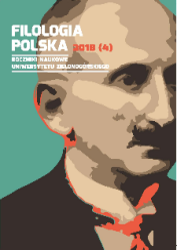The interpretative framework of the senses in the early and late novels by Jerzy Pilch
Keywords
Abstract
The article is devoted to the conceptualization of the senses by Jerzy Pilch included in the interpretation framework of each of them. Thanks to the research, one can see how the hierarchy of the author’s perceptions is presented and which ranges dominate in them. The material comes from Jerzy Pilch’s two early novels Spis cudzołożnic [List of adulteers] (1993) and Inne rozkosze [Other pleasures] (1995) and the last two Zuza albo czas oddalenia [Zuza or the time of distance] (2015) and Portret młodej wenecjanki [Portrait of a young Venetian woman] (2017). On this basis, we can see a crosssectional image emerging from all material. It is also possible to capture the differences between the older and newer parts of the artist’s output.
References
LITERATURA CYTOWANA
Literatura podmiotowa
Pilch J., Inne rozkosze, Poznań 1995.
[Google Scholar]
Pilch J., Spis cudzołożnic. Proza podróżna, Kraków 2002.
[Google Scholar]
Pilch J., Zuza albo czas oddalenia, Kraków 2015.
[Google Scholar]
Pilch J., Portret młodej wenecjanki, Kraków 2017.
[Google Scholar]
Literatura przedmiotowa
Fillmore Ch.J., Frame Semantics, [w:] Linguistics in the Morning Calm, red. The Linguistics Society of Korea, Seoul 1982.
[Google Scholar]
Fillmore Ch.J., Frames and the semantics of understanding, „Quaderni di Semantica” 1985, Vol. 6.2.
[Google Scholar]
Fillmore Ch.J., Atkins Beryl T., Towards a Frame-Based Lexocon: The Semantics of RISK and its Neighbors, [w:] Frames, Fields and Contrasts. New Essays in Semantic and Lexical Organization, eds. A.E. Lehrer, F. Kittay, New Jersey 1992.
[Google Scholar]
Johnson Christopher R., Petruck Miriam R.L., Baker Collin F., Ellsworth M., Ruppenhofer J., Fillmore Ch.J., FrameNet: Theory and Practice. Version 1.1, 2003, [book.pdf] [13.03.2015].
[Google Scholar]
Kładoczny P., Semantyka nazw dźwięków w języku polskim, t. 1-2, Łask 2012.
[Google Scholar]
Kładoczny P., Rama interpretacyjna percepcji słuchowej, [w:] Narracyjność języka i kultury, red. D. Filar, D. Piekarczyk, Lublin 2014.
[Google Scholar]
Kładoczny P., Konceptualizacja percepcji słuchowej i innych zmysłów w „Drugim dzienniku” Jerzego Pilcha, w: Słowo. Obraz. Dźwięk, red. Elżbieta Skorupska-Raczyńska, Joanna Rutkowska, Gorzów Wielkopolski 2016.
[Google Scholar]
Kładoczny P, Konceputalizacja zmysłów w twórczości Adama Mickiewicza, „Filologia Polska. Roczniki Naukowe Uniwersytetu Zielonogórskiego” 2016, nr 2.
[Google Scholar]
Linde-Usiekniewicz J., Od przypadków głębokich do elementów ram we FrameNecie, [w:] Ramki: rygorystyczna aplikacja metodologii kognitywno-interpretacyjnej, red. M. Zawisławska, Warszawa 2010.
[Google Scholar]
Ramki: rygorystyczna aplikacja metodologii kognitywno-interpretacyjnej, red. M. Zawisławska, Warszawa 2010.
[Google Scholar]
Ruppenhofer J., Ellsworth M., Petruck Miriam R.L., Johnson Christopher R., Scheffczyk J., FrameNet II: Extended Theory and Practice, [revised November 1, 2016] [book.pdf] [3.02.2018].
[Google Scholar]
Zawisławska M., Czasowniki oznaczające percepcję wzrokową we współczesnej polszczyźnie. Ujęcie kognitywne, Wydział Polonistyki Uniwersytetu Warszawskiego, Warszawa 2004.
[Google Scholar]
Zawisławska M., Ramy interpretacyjne jako narzędzie opisu znaczenia, [w:] Ramki: rygorystyczna aplikacja metodologii kognitywno-interpretacyjnej, red. M. Zawisławska, Warszawa 2010.
[Google Scholar]
Preview
Downloads
Published
How to Cite
Issue
Section
Categories
Copyright & License

This work is licensed under a Creative Commons Attribution-NonCommercial-NoDerivatives 4.0 International License.
Copyrights (a). In principle, authors who are not employed by the University of Zielona Góra retain the copyright, including publishing rights to the articles, without restrictions.
Copyrights (b). In principle, authors who are employed by the University of Zielona Góra, do not retain the copyright, including publishing rights to the articles. In such cases the copyright holder is the University of Zielona Góra.
Print ISSN
2450-3584-
Abstract86











































